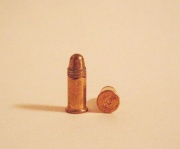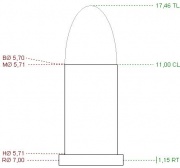.22 Short
| .22 Short | |||||||||||||||||||
|---|---|---|---|---|---|---|---|---|---|---|---|---|---|---|---|---|---|---|---|

| |||||||||||||||||||
| .22 Short, left; .22 Long Rifle, right | |||||||||||||||||||
| Type | Rimfire | ||||||||||||||||||
| Country of Origin | United States | ||||||||||||||||||
| Specifications | |||||||||||||||||||
| Bullet Ø | .223 in (5.7 mm) | ||||||||||||||||||
| Neck Ø | .224 in (5.7 mm) | ||||||||||||||||||
| Base Ø | .225 in (5.7 mm) | ||||||||||||||||||
| Rim Ø | .273 in (6.9 mm) | ||||||||||||||||||
| Rim Thickness | .040 in (1.0 mm) | ||||||||||||||||||
| Case Length | .423 in (10.7 mm) | ||||||||||||||||||
| Full Length | .686 in (17.4 mm) | ||||||||||||||||||
| Primer | rimfire | ||||||||||||||||||
| Production & Service | |||||||||||||||||||
| Designer | Smith & Wesson | ||||||||||||||||||
| Design Date | 1857 | ||||||||||||||||||
| Manufacturer | everybody | ||||||||||||||||||
| Production Dates | 1857-present | ||||||||||||||||||
| Ballistic Performance Sampling | |||||||||||||||||||
| |||||||||||||||||||
.22 Short is a variety of .22 caliber (5.6 mm) rimfire ammunition. Developed in 1857 for the first Smith and Wesson revolver, the .22 Short was the first American metallic cartridge. The original loading was a 29 grain (1.88 g) bullet and 4 grains (260 mg) of black powder. Developed for self defense, the modern .22 Short, though still used in a few pocket pistols and mini-revolvers, is mainly used as a quiet round for practice by the recreational shooter. Due to its low recoil and good inherent accuracy, the .22 Short was used for the Olympic 25 m Rapid Fire Pistol event until 2004, and they were also allowed in the shooting part of modern pentathlon competitions before it switched to air pistols. There is also a .22 short blank for use in starting pistols.
[edit] Overview

Bullets are lead (usually coated with grease or wax or copper plated), in round nose or hollow point styles. The standard velocity .22 Short launches a 29 grain (1.88 g) bullet at 1,045 ft/s (319 m/s) with 70 ft·lbf (95 J) of energy from a 22 in (559 mm) rifle barrel and can penetrate 2 inches of soft pine.[1] As a hunting round, the high velocity hollow point Short is useful only for small game such as tree squirrels and rabbits. In the American South, the .22 Short hollow point is still very popular for use on raccoons, which are treed at night using dogs. In some states, the .22 Short is the only legal round to use for such hunting. For small game hunting in general, the greater energy and wider ammunition selection of the .22 Long Rifle makes it a far superior choice.
Many ammunition companies still produce .22 Shorts, and in a fairly wide variety. CCI makes several types: a CB Short with a 29 grain bullet at 727 ft/s (222 m/s), Target Shorts with a 29 grain bullet at 830 ft/s (250 m/s), their standard Short round with a 29 grain plated round nose bullet at 1,080 ft/s (330 m/s), and a high speed hunting load with a 27 grain plated hollow point bullet at 1,105 ft/s (337 m/s). Fiocchi makes their Exacta Compensated Super Match SM200 with a 29 grain lead round nose at 650 ft/s (200 m/s). Remington produces a high velocity plated 29 grain round nose at 1,095 ft/s (334 m/s). Aguila makes both a match round with a 29 grain lead bullet at 1,095 ft/s (334 m/s), and a "high speed" round with a 29 grain plated bullet, also at 1,095 ft/s (334 m/s). Also available is the fine RWS R25 match ammunition, which shoots a 29 grain bullet at 560 ft/s (170 m/s). Eley also makes their Rapid Fire Match cartridge, which shoots a 29 grain bullet at 750 ft/s (230 m/s).
Most of the target oriented and CB shorts are very quiet, due to being subsonic. Most are as quiet, if not quieter, than the average air rifle when fired from a full length rifle barrel.
There have been many rifles chambered for the .22 Short over the years, but none are currently in production. Many rifles in .22 Short were made between 1900–1940, mostly intended for gallery shooting and small game hunting. Remington and Winchester produced the most rifles in .22 Short. Remington has made their Model 24 and Model 241 "Speedmaster" semi-autos as well as their Model 12 and 121 "Fieldmaster" pump actions. Winchester produced the .22 Short in a variety of different rifles including the 1873 lever action, 1885 single shot (in both Low Wall and High Wall variations), Model 1890, 1906 and 62A pump actions, Model 74 semi-auto and the Model 61 pump action. Many of their bolt action rifles were available on a special order basis in .22 Short. Browning/FN also produced their dainty takedown semi-auto in .22 Short, on the same John Browning design upon which the Remington Model 24 is based.
Note that many of these rifles are now collectors items, particularly the Winchesters, and demand a premium in price over the same rifle chambered in .22 LR.
It should also be noted that many rifles marked ".22 Short, Long and LR" will not shoot Short rounds with the same degree of accuracy as they will an LR. This is due to the .22 Short round using a 27–29 grain bullet, which is intended for rifles with a 1-20 to 1-24 twist. A rifle for "Short, Long and LR" will normally have a 1-16 twist, which is proper for use with .22 LR rounds using 40 grain bullets. If one is intending to shoot only Shorts, and wants a high degree of accuracy, they would be best served with a rifle chambered for the Short only.
[edit] See also
- .22 BB
- .22 CB
- .22 Long
- .22 Magnum
- List of rifle cartridges
- 5 mm caliber—Other cartridges of similar size.
[edit] References
- ↑ 1.0 1.1 Cartridges of the World 11th Edition, Book by Frank C. Barnes, Edited by Stan Skinner, Gun Digest Books, 2006, pp. 476, 490, 492. ISBN 0-89689-297-2.

This article about ammunition is just a stub, and should be expanded

